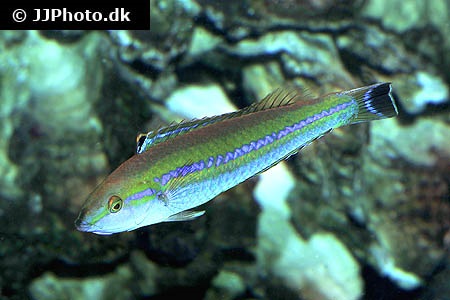Pseudojuloides cerasinus

| Latin name | Pseudojuloides cerasinus - (Snyder, 1904) |
|---|---|
| Local name | Smalltail wrasse |
| Family | Labridae - Pseudojuloides |
| Origin | East Indian Ocean, West Indian Ocean, Japan, Indonesia, East Pacific, Central/West Pacific |
| Max length | 12 cm (4.7") |
| Minimum volume |
600 l (158 gal) |
|---|---|
| Hardiness |
Average |
| Suitable for aquarium |
Experience, preparation and extra care required |
| Reef safe |
Reef safe with caution |
| Aggressiveness | Mostly peaceful but might be aggressive towards similar species |
| Recommended |
Small crustaceans (Krill, mysis, artemia...) Zooplankton (Cyclops, pods...) |
|---|
This species is known to jump out of open aquaria.
This species requires feeding 4 or more times a day.
Hard to give this species the correct nutrition and is therefore hard to keep alive.
This species must be fed with an appropriately varied diet.
This species is very sensitive during transportation and acclimatizing into the aquarium.
This species needs a minimum of 2 inch (5 cm) of sand in the aquarium bottom, so it can dig itself down when afraid or needing to sleep.
This species thrives best when there is a sufficiently large amount of micro life (copepods, amphipods or similar) in the aquarium, so that the it can always find their own food.
This species can live as a pair (male and female).
This species can change gender from female to male.
When a male is needed, a female changes sex and takes on the role.
Pencil Wrasses are a tempting buy, but can be hard to keep successfully for a long time. After a while many die due to malnutrition.
If one is determined to try, it is vital that there is a healthy amount of pods in the aquarium so they can find their own food. In addition it is important to supplement feed, several times a day with a variety of foods, like Mysis, Artemia and cyclops.
These fish dig themselves in at night to sleep or when they feel threatened.
Wrasses are nearly always seen in reef aquaria, since many of the species are both attractive and useful in battling a range of unwanted invertebrates like i.e. flatworms, pyramide snails.
These fish live of everything from zooplankton to large crustaceans, sea urchins and the like.
The needs and behaviour of Wrasses vary greatly, so it is vital to familiarize oneself with the specific species before buying one.
| Aquarium trade | Yes |
|---|---|
| Distribution | Indo-Pacific: East Africa to the Hawaiian, Society, and Austral islands, north to the Izu Islands, south to Lord Howe Island. |
| English common names |
Smalltail wrasse Candy wrasse Pencil wrasse |
| French common names |
Labre cerise |
Bob Fenner. The Pencil Wrasses, Genus Pseudojuloides - Wet Web Media - (English)
Scott W. Michael. 2009. Wrasses and Parrotfishes (Reef Fishes Series Book 5) - TFH Publications / Microcosm Ltd. - (English)

